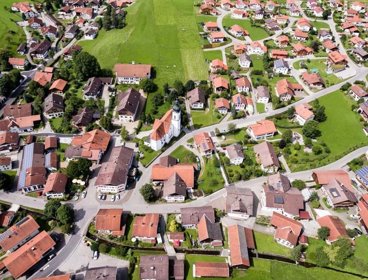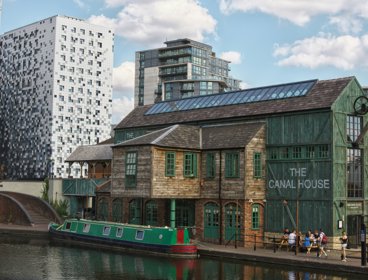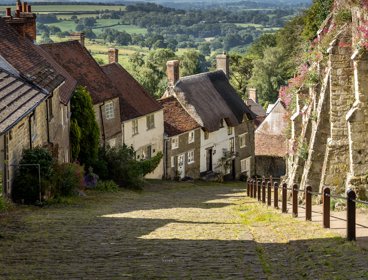What is place profiling?
Place profiling uses a variety of fieldwork techniques to provide students with a composite picture of the social, economic and environmental facets of a place they are studying. It is intended to develop the way your learners see, hear and interact with the spaces they inhabit - to deepen their experience of place.
Why use place profiling?
In the past, geography fieldwork has encouraged students to engage in lengthy, quantitative analysis in the field - something that can obstruct a more holistic understanding of place. Place profiling aims to counter this by using a wide range of simple and complementary qualitative methods which should help your students build up an accurate profile of their place. Most of the activities included here are extremely short and simple and do not require any specialised equipment. Many are simple sensory learning experiences that can be used across the key stages.
In what contexts could these activities be used?
Most of the activities suggested here are broad enough to be adapted to any local place in the UK, though some inevitably have an urban bias. They have been trialled in Bow, Stratford and Barking, east London.
Activity: I am a camera
Suitable for: All Key Stages
Equipment: None/blindfold
Timing: Fieldwork starter (Five to 15 mins)
Instructions: Students should pair up. One person should close their eyes or put on a blindfold whilst the other person guides them to a particular viewpoint. The sighted person should then describe the view to their partner as if they were a camera taking a photo.
Activity: Observe... participate
Suitable for: All Key Stages
Equipment: Notebook/diary
Timing: ongoing throughout fieldwork investigation
Instructions: This task uses the methodology of participant observation, encouraging students to develop their sense of place and to immerse themselves in the culture and environment of the place. Participant observation can be both intentional and incidental. Encourage your students to take part in activities in and around their local area; visit shops, eat in local cafes, use public transport etc in order to get a better sense of place. They should note down their observations in a fieldwork notebook.
Top tips: Encourage your students to think about the people they observe, thinking both about who they are and how they are using a particular place. Who is excluded from this place? What can their observations tell us about the nature of their local area?
Activity: Shopping challenge
Suitable for: All Key Stages
Equipment: Shopping list
Timing: 30 minutes
Instructions: Give your students 30 minutes to do a shopping challenge in their local area, finding all of the items on the list provided and noting down how easy they were to locate (they don't need to buy them). This activity should help students to think about the area's economic geography. The items on the shopping list below are only suggestions and could easily be modified to suit your local area. As a plenary ask students why certain goods were easy or difficult to find and what this tells you about the geography of the area.
Shopping list:
| Item | How easy was it to find? | Where did you find it? |
| A designer handbag | ||
| A latte | ||
| Handmade jewellery | ||
| Something from a pound shop | ||
| An international calling card | ||
| Caviar | ||
| A sandwich under a pound | ||
| Something from a pawn shop |
Activity: Place check
Suitable for: All Key Stages
Equipment: Digital camera, notebook, place check grid
Timing: 30 minutes
Instructions: Place check is a tool that local communities can use to assess what services and features need to be changed or improved in their local area. Ask your students to imagine they are a local resident. As they walk around the area, they should fill out the place check form to highlight the things that they like and dislike:
| Location | What do we like? What things need protecting? Can we have more of the same? | What don't we like? What needs changing now? What problems are getting worse? |
Students should take photographs to support their findings.
Find out more at place check.
Activity: Clone town
Suitable for: Key Stages 4 and 5
Equipment: Dalston illustration
Timing: 30 minutes
Instructions: This activity introduces the concept of clone towns (which may need to be explained to the students) and encourages students to consider those features that can make a place unique and individual. Local people in Dalston, east London are worried that redevelopment of their local area is turning it into a clone town. Use this Dalston illustration as a prompt to encourage students to think about strategies that your local council can put in place to ensure the same thing does not happen during the development of their local area.
Activity: Getting into Character
Suitable for: All Key Stages
Equipment: Character cards
Timing: Fieldwork starter (Five to 15 minutes)
Instructions: First prepare a set of character cards that represent a range of local stakeholders. These cards (downloadable below) were used during a field trip to the Olympic site but can be adapted for use with your class. Students should pick a character card. They should tell their partner who their character is and then describe what their character feels about the view they are looking at. Their partner should be encouraged to question them about their feelings and why they feel a certain way.
Activity: I Spy a Stakeholder
Suitable for: Key Stages 4 and 5
Equipment: None
Timing: Fieldwork starter (Five to 15 minutes)
Instructions: This activity would work best in a local area undergoing some kind of redevelopment. Students should take it in turns to spy visual evidence of stakeholders involved in the redevelopment process. They might spot, for instance, the logo of a sponsor on a hoarding or the name of a public sector organisation on a vehicle. For each stakeholder they notice they should describe the type of involvement they have in the project.
Are they:
-
Public, private or voluntary?
-
Public partners?
-
Private firms?
-
Headline sponsors?
-
Not for profit organisations?
-
Government/EU departments?
Activity: Past and Future Visioning
Suitable for: All Key Stages
Equipment: Sketchbooks
Timing: 20 minutes
Instructions: This task encourages students to think about the changes in the landscape in the past and in the future. Students are taken to a particular viewpoint. They have 20 minutes to draw two sketches. Their first sketch should illustrate what they think this view looked like ten years ago and the second should illustrate what they think it will look like in ten years time. They should annotate their sketches and suggest the causes of the changes they've drawn.
Top tips: A potential extension activity for gifted and talented pupils is to encourage them to start interrogating their local place as a layered artefact or palimpsest. Their place was not made/created in one day - it developed over a long period of time. Encourage students to use their sketches to think about the historical layers of their place.
palimpsest
/palimpsest/
noun two something reused or altered but still bearing visible traces of its earlier form: the house is a palimpsest of the taste of successive owners.
Source: Oxford dictionaries
Activity: Tuning in to soundscapes
Suitable for: All Key Stages
Equipment: None/paper or notebook
Timing: Fieldwork starter (five to 15 mins)
Instructions: In this task, students investigate place through a sense other than sight: their hearing. They consider the source and type of sounds they can hear, giving them a deeper understanding of the place they are studying. Students should ask their partner to close their eyes and name every sound they can hear. What do these sounds tell us about the place they are investigating? Next, encourage them to draw a sound map to illustrate their findings. From a central point on their piece of paper, they should draw a line in the direction of each sound they hear. The thickness of the line should indicate the volume of each sound, the length of the line should show how close it is. Students can also categorise the sounds according to whether they are human or natural, and think about how their sound maps they have created might be different at other times or in other places.
Activity: Picture this quote...
Suitable for: Key Stage 5
Equipment: Digital camera, statements
Timing: 20 minutes
Instructions: Present your students with a series of quotes illustrating a range of viewpoints concerning their local place. Students should aim to take a photo which acts as a visual representation of each quote. They should be able to justify why the photo they have taken matches the quote.
These are a couple of examples we used with our Key Stage 5 pupils on a fieldtrip to the Olympic site:
-
"The Games will bring thousands of new jobs in sectors including construction, hospitality, media and environmental services." (LDA)
-
"In the boroughs affected by this 2012 game-show rabies, long-established businesses have closed down, travellers have been expelled from edgeland settlements and allotment holders turned out..." (Iain Sinclair)
-
"The redevelopment ignores the fact that much of the Lower Lea Valley is an extensive network of waterways with important wildlife habitats on a key migratory route." (River Leas Trust)
Activity: Urban recall
Suitable for: All Key Stages
Equipment: A3 paper, pencils
Timing: 20 minutes - an ideal fieldwork plenary session
Instructions: At the end of a fieldwork session provide students with an A3 sheet of paper. They should plot a visual memory map of their fieldwork journey. The map can be a visual representation of the spatial and temporal journey they took during their time out of the classroom. They should annotate their map with things they learnt during the day - making sure they mark where and when they gained particular pieces of knowledge.
Activity: Story stick
Suitable for: Key Stage 3
Equipment: Thread or elastic bands, stick
Timing: 20 minutes
Instructions: This activity may seem best suited to Key Stage 2 but can work equally well with older students. Provide groups of students with a stick at the start of a fieldwork journey. They should aim to collect small (free) items - both natural and man made - along their journey which they can tie onto their stick with thread or with an elastic band. As an alternative, you could provide students with a length of string to which they tie their items.
Top tip: On your return to school, encourage groups of students to share the story of their journey with others. What does each item tell them about the place they have been investigating?
Activity: Urban Detective
Suitable for: Key Stages 3 & 4
Equipment: None
Timing: 30 minutes
Instructions: Ask your students to imagine they are aliens that have landed from outer space in the local area. They should take on the role of geographical detectives to try and figure out where they are and who lives here.
For example:
| Clue | What it tells us about ‘our place' |
| Lahore Curry House | Lahore is a place in Pakistan. I would guess that this means some people who are born in Pakistan live around here. |
| Lots of buses going up and down Commercial Street | This is a busy place where people travel on buses to get to work and school. |
Top tips: This activity is all about encouraging students to interrogate the most prosaic features of their place. At first they may find it difficult to pick out clues from the landscape they are interrogating so provide model examples to get your students started.
Activity: Sign language
Suitable for: All Key Stages
Equipment: Digital camera
Timing: 20 minutes
Instructions: Students are given 20 minutes to explore their local place with a camera. They should take 10 photos of signs (they can be street signs, shop signs or advertisements) that tell them what makes their place unique.
Top tip: To make the task a bit harder, impose a rule which dictates that photos can not feature either people or buildings.
Activity: Missing Link
Suitable for: Key Stages 3 and 4
Equipment: None
Timing: 20 minutes
Instructions: There are likely to have been a number of key economic, social or political processes that have shaped your local area. Take pupils into the field and ask them what different places would look like if they had not been shaped by particular human processes (for example, immigration, building of social housing, CCTV or development of heavy industry).
Activity: I Spy Geography
Suitable for: Key Stage 3
Equipment: None
Timing: Five minute fieldwork starter
Instructions: Students take it in turns to spy something in the field that has a connection to a geographical phenomena or process that they have studied in class. For instance ‘I spy an empty shop. I think this is geography because it might have closed down because of the recession.' Alternatively, one member of the class could spot the feature/process, and the rest of the class could make suggestions as to why it might be considered geographical.
Top Tip: Adapt this activity for a topic you are studying in class; for example ‘I spy regeneration'.
Activity: Drawing with words
Suitable for: Key Stage 3
Equipment: Sketchbooks and pencils
Timing: 10 minute fieldwork starter
Instructions: Students sit back to back and describe the landscape they can see for their partner to draw. This activity should develop students' questioning and listening skills as well as encouraging them to see and interrogate their local place more closely.
Activity: Treasure Hunt
Suitable for: Key Stage 3
Equipment: Clipboard, cameras, local maps, treasure hunt.
Timing: One and a half hours
Instructions: This activity takes some preparation but the results are very rewarding. It develops students' exploration and map skills. Students should look for treasure hunt clues in their local area - photograph them and mark them on a local area map. Encourage students to work through the clues in order and hide treasure at the last clue for the winning group to discover. This is a sample treasure hunt used with a class in Bow, east London.
| Which street was it on? | Which grid-square is it in? | |
| A weather vane | ||
| Post Office | ||
| Railway bridge | ||
| A pub | ||
| A Sikh temple | ||
| A house with a blue plaque on the wall.
For an extra point - when was this house built? |
||
| A red front door | ||
| A unicorn! | ||
| A detached house | ||
| A door knocker with a lion's face! |
Top tips: Follow up your treasure hunt with classroom based mapping exercise. Students should draw their route on their map and annotate it with the photographs they took as well as additional information about the geography of their local area.
Activity: The whole world all in one place
Suitable for: Key Stages 3 and 4
Equipment: Notebook, digital camera
Timing: 30 minutes
Instructions: This activity is probably most suitable for major urban areas. How many different countries can be found in one place? Students should look for evidence of anything in their locality that links it to somewhere else in the world.
Top tips: Follow-up this activity back in the classroom with a mapping exercise - students should locate evidence of the global in their local area on a world map.
Activity: Green Mapping
Suitable for: Key Stages 3 and 4
Equipment: Local maps, green map key
Timing: 30 minutes
Instructions: Encourage students to explore their local area using the alternative mapping iconography of green mapping. Green mapping encourages students to think about the positive and negative environmental and community based value of their local area, as well as potential environmental hazards.
More info: find out more about green mapping, plus a full selection of green map keys
Activity: In/out
Suitable for: Key Stages 3 and 4
Equipment: Character cards
Timing: 20 minutes
Instructions: This activity is useful to explore social inclusion/exclusion. Students should imagine they are a series of characters. They should then think about the local space they are visiting and consider which of the characters are allowed to be there - and who is not permitted access. How is inclusion and exclusion policed?
Name: Charlie
Age: 58
Lives: At the moment Charlie does not have a home and lives in cardboard city under the local motorway bridge.
Job: Charlie can't get a job because he has not got an address.
Interests: Hanging out with his friends
Name: Amit
Age: 32
Lives: New housing development near the centre of town
Job: Property lawyer
Interests: Shopping, drinking in bars with his mates, snowboarding
Name: Norah
Age: 28
Lives: semi-detached house
Job: full time mother
Interests: Norah spends a lot of time with her two young kids at the local park.
Name: Harry
Age: 89
Lives: Sheltered accommodation
Job: Retired bus driver
Interests: Harry likes playing bridge with his friends and visiting his local library.
Top tips: As an extension, students could consider the types of shops and services that their character might need in the local area. They should then navigate the area, recording their route on a map and highlighting the shops and services that cater for their character. How well does the area cater for their needs?



